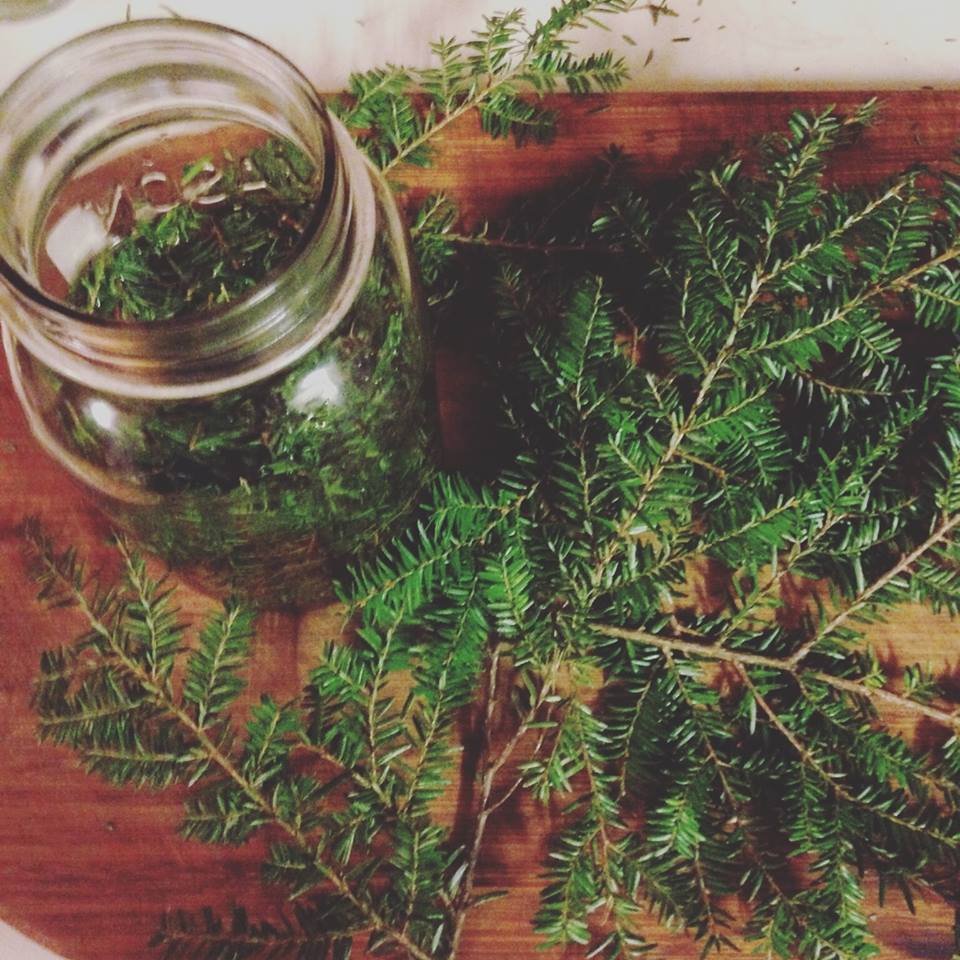Eastern Hemlock Medicine
Eastern Hemlock (Tsuga canadensis): A Materia Medica
Part Used: Needles, Inner Bark, Sap/Pitch. Traditionally, the entire young twigs were used.
Habitat & Ecology: Prefers moist, well-drained, acidic soils. Often grows in pure stands in moist cool valleys and ravines. Also found in rocky outcrops and north-facing bluffs. Along with white pine, definitely the most common evergreen found in our local woods. Grows to about 2,400 ft elevation. Frequently associates with White Pine (Pinus strobus), and Yellow Birch (Betula alleghaniensis), or forms pure stands. A common medicinal found growing beneath hemlock is Goldthread (Coptis groenlandica). The pure stands create their own moist and slightly humid microclimate, and provide excellent winter shelter for many species of wildlife. These trees play a key role in stream ecology, shading the waters of mountain streams and headwaters and keeping them cool, thus creating habitat for native fish and invertebrates. They also stabilize the soil in the steep ravines they commonly grow in, preventing erosion.
Description: Along with White Pine, definitely the most common evergreen found in our forests. Grows in a distinctive pyramidical shape. Short needles (3/8-5/8”) growing in 2 rows off the branch. Flat, flexible, and rounded at the tip (not sharp). Shiny dark green above with 2 white lines below. Has very small cones (5/8-3/4” long). Could be confused with the poisonous Canada Yew (Taxus canadensis, Fam Taxacaea/ Yew Family), sometimes called Ground Hemlock, (a low-growing native forest shrub that can be toxic at large doses internally, but this species has dark green needles both above and below. Can reach up to 175 ft tall and over 6 ft in diameter. Shares a common name with Poison Hemlock (Conium maculatum), but is a completely different plant.
Collection: The needles can be collected anytime, as well as the bark. To get the medicinal properties of the needles, inner bark/bark and sap all together, harvest the twigs. The young, bright green needles that grow in late spring are especially high in Vit C and make a great trailside snack and medicine. Never girdle a tree when collecting bark, as it will kill the tree. I love gathering dropped branches from winter storms- as long as the needles are still nice and fragrant.
Taste: Bitter, Pungent, Sweet, Sour
Energetics: Warm, Dry
Constituents: Essential Oils, Tannins (esp in the bark)
Herbal Actions: Astringent, Circulatory Stimulant, Diaporetic, Diuretic, Expectorant, Immune-enhancer,
Medicinal Uses: The needles are the most medicinal parts of this species, and the inner bark and sap have some use as well. The young new growth at the tips can be eaten and are a spring tonic. They are deliciously sour, tonifying the digestion, promoting digestive secretions, and waking up the liver. Like White Pine, the needles are very rich in vitamin c, and build immunity during the cold and flu season, and can help lessen the duration of an illness if it has already set-in. Hemlock has an affinity for the lungs and is helpful for wet, boggy cough and as over-all tonic for the respiratory system. It makes a delicious tea, especially when mixed with wild medicinal fruits such as Rose Hips (Rosa sp), Elderberry (Sambucus nigra), and Hawthorn (Crateagus sp). Rich in tannins, the bark is very astringent, and can be used as a wash for any skin irritations, diarrhea, to tonify the skin, and help reduce excess secretions in the body. The sap is also medicinal and can be used similarly to Pine species- as a warming expectorant in a chest rub, as an oil for sore muscles, rheumatic pains, to draw out splinters, and so on. Also, hemlock is a host for our native adaptogenic muchroom, Reishi (Ganoderma tsugae)! In the forest, hemlock has a very calming, soothing presence, and it tends to do the same in medicinal preparations. It is a wonderful addition to any bioregional incense blend.
Preparation: Tea, Salve, Incense, Elixer, Honey, Infused Oil, Cordial, Ghee, Syrup, Vinegar, Bath Salt/Scrub, Essential Oil
Dosage: Tea- 1 tsp: 1 cup water. Drink freely. Vinegar, Honey, Cordial, Oil, Salve, Cream, Elixer/Cordial- Enjoy freely
Contraindications: Avoid in high dosages in pregnancy due to high Vitamin C content
Other: The inner bark can be used as survival food, and is very nutritious. It can simply be chewed and swallowed, can be cut into strips and boiled to make “hemlock noodles,” or dried and ground into flour for baking. This inner bark can also be soaked to produce a pink dye. The bark is very high in tannins and was formerly much used in the tanning industry, and at one point the tree was even threatened in the northeast due to overharvest. Tsuga, derived from the Japanese words for tree (tsu) mother (ga): the “mother of trees.” This tree is currently also being attacked by the Hemlock Wooly Adelgid (Adelges tsugae), an aphidlike insect from Asia that looks like white wooly fluff on the underside of Hemlock needles. DO NOT harvest from this tree or surrounding trees if you find this insect.
Hemlock Cordial✨
To Make:
Roughly chop your Hemlock (Tsuga canadensis) needles and thin twigs (kitchen scissors or clippers work great for this). Put in a glass jar and cover the Hemlock with roughly 75% brandy (or any liquor that is at atleast 40% alcohol) and 25% raw honey. Let sit for a month (or as long as you want) and strain. This can be sipped on as a cordial, added to bubbly water or tonic water (it's esp nice mixed with tonic and blueberry soda) or take by the spoonful as medicine. It's delicious and tastes like the forest! Hemlock is warming and a very gentle circulatory stimulant. It is rich in immune-stimulating essential oils. Hemlock has a special affinity for the respiratory system, which makes sense-remember, trees are the lungs of the earth! It helps promote respiratory health, heals wet and boggy coughs, clears congestion from both the lungs and sinuses, and has some anti-microbial properties as well.
Enjoy!

